The Sunbeam Swagman.
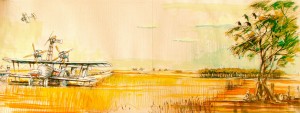
The first Swagman performs a perfect landing and harvesting of 26 bushells of wheat upon arriving at Mr and Mrs Joe Blake’s property, “Entropy” in the Mallee Sept 27th 1926.
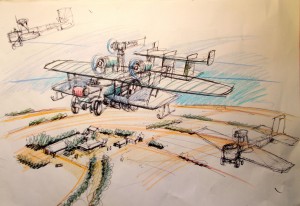
Graphic Designer Claude Flight’s sketches for the Swagman poster that changed outback Australia’s view of itself from isolated and insular to ‘slightly less isolated and arguably less insular’.
Dear reader, once again another stirring tale that describes ” what could’ve been” in the quest to make this country truly innovative. This tale, entirely true, will pluck the heart strings of those who are born, bred, and bored by the opressive weight of living in rural Australia. Or to use the epithet, ” In space, no one can hear you scream”. And if they didn’t care they wouldn’t bother doing anything about it either’.
Few aircraft manufacturers can boast the credentials awarded to the ‘Sunbeam Swagman’, Australia’s, first ever trans continental passenger airliner. Conceived originally as a hybrid to provide both land based and air transport for short hop routes, the Swagman was revolutionary in almost every respect, and at its height it captured the public imagination like none other for ‘can-do’, improvisation and durability. Hitherto, the Sunbeam manufacturing company was almost the sole producer of milking equipment, portable shearing machines; ‘The Little Wonder’, and ‘the Little Wonder Junior’ and shearers hand-pieces. The “Swagman” changed that forever.
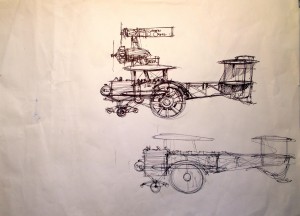
Design Sketch of Swagman Mk1 indicating Lister crawler wheel and hybridized Sunbeam mower/harvester landing gear.
Across Australia and into New Zealand the Sunbeam was synonymous with reliability and durability, and Sunbeam retailers and agents were found in almost every town. As the caption went; ‘from Weipa to Wyndham, from Darnum to Dampier, Beechworth to Broome, on any ol track, there’s a sunbeam that shines, o’er all the Outback’ And shine the products did, with the expansion of wool and the opening up of the hinterland to mechanised agriculture post World War One. However bright, the Sunbeam company was compromised by the influx of cheaper foreign derived imports. For instance the general electric range of shearing gear, ‘The General Electric Jillaroo’ and the ‘Westinghouse Whether’, and then the New Zealand manufactured ‘Kia-ora Kiwi’, and then the smaller ‘Kiwi Kompact’ , which could outperform the Sunbeam and offered a wider comb. The directors of Sunbeam then devised a perfect counter strategy. 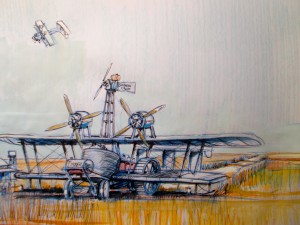 By consolidating their strengths for machining, fabrication and improvisation they contracted the well established firm Lister, manufacturers of heavy duty diesels and generators to assist them in the very first terrestrial and air proven commercial aircraft, ‘the Swagman’. It combined all terrain land capability, with the adaptation of two very large Lister crawler wheels, re-made in molybdenum, and augmented this with some very simple construction techniques found on most farms.
By consolidating their strengths for machining, fabrication and improvisation they contracted the well established firm Lister, manufacturers of heavy duty diesels and generators to assist them in the very first terrestrial and air proven commercial aircraft, ‘the Swagman’. It combined all terrain land capability, with the adaptation of two very large Lister crawler wheels, re-made in molybdenum, and augmented this with some very simple construction techniques found on most farms.
The idea was ingenious, rather than homestead’s having to wait weeks of often months for spare parts the Swagman, could land, taxi, navigate anywhere, and a specialist team of artificers would manufacture replacement parts on site. Such savings made the Swagman a world beater, and it was also discovered that its sturdy frame and augmentation of Southern cross windmill gearing and gantry, the Swagman could perform limited VTOL capability and had wing capacity to carry at least eight passengers. In an instant the problem of access and provisioning to outlying homesteads was resolved. Unveiled at the 1925 Wagga Wagga field day the Swagmen made a spectacular debut, by winning both the short-hop aero race and then competing and winning the very popular tractor pull.
Cleverly, additional horsepower was augmented by a pedal and chain system then very popular on the ‘Sunbeam Ju-Ju’ or ‘Junior-junior pedal car’, and thus equipped gave true grunt to the tried and tested Sunbeam powerplant that was geared, (three engines) by an ingenious use of pulleys to provide both lift and traction with a simple engagement lever. After initial testing the Swagman began a popular touring exhibition and demonstrated its performance capability by touring outback stations as part of an Australia wide promotion, ‘Let a Sunbeam shine down on you’ to the delight of those isolated outposts. By 1928, Sunbeam had an impregnable reputation and was poised for massive orders and additional overseas deliveries, until one day on Jan 27th 1929, disaster struck.
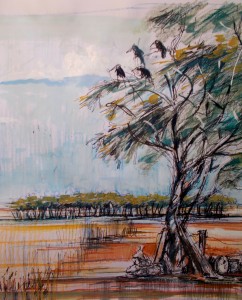
Only fragments of the Sunbeam survive on the odd farm in the Mallee these days
Piloted by the celebrated aviatrix Marjery Melanoid, the Swagman, circling to land at sundown, encountered a severe headwind. Extra power was applied by the passengers, and then, buffeted by increasing wind, the pilot skillfully activated the ground wheels for a forced landing. Gliding over the homestead, and recognising an airstrip to the edge of a billabong, the Swagman descended, and was just about to land when the forward pilot’s position glanced a Mallee root. In an instant the forward mowing mechanism was snagged and the mechanism imploded, killing the pilot. Thus pilotless, the passengers pedaling furiously gathered just enough lift to clear the homestead, but as described by witnesses, performed a perfect arc, stalled and then plummeted into a Coolabah tree and exploded on impact, killing all on board. The subsequent enquiry revealed ‘pedal fatigue’, a hitherto undiagnosed condition evidenced by users of the Sunbeam little junior junior, but because of the mean age of users, (three to four years) their condition was ignored. Fractures of the subframe also indicated the impact of the collision with the Mallee, which gave birth to an expression still in common parlance today, “Mallee rooted”. The remaining fleet were converted into tractors, and the rear sections may still be seen around homesteads to this day employed as tank-stands or sheep races. No complete Swagmen survive, proving the legend, that ‘once a jaunty Swagman crashed by a Billabong, and burnt in the branch of a Coolabah tree’.
